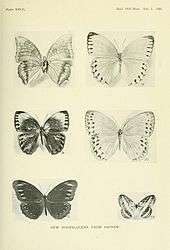Stichophthalma nourmahal
Stichophthalma nourmahal (the chocolate jungle queen),[1] is a South Asian butterfly that belongs to the Morphinae subfamily of the brush-footed butterflies family.
| Chocolate jungle queen | |
|---|---|
 | |
| Scientific classification | |
| Kingdom: | |
| Phylum: | |
| Class: | |
| Order: | |
| Family: | |
| Genus: | |
| Species: | S. nourmahal |
| Binomial name | |
| Stichophthalma nourmahal (Westwood, 1851) | |
Distribution

The chocolate jungle queen ranges from Sikkim, Assam and Nagaland in India and also in Bhutan.[1][2]
Description
The male upperside is bright chocolate brown. Its forewing has a broad, curved, oblique preapical band from costa to termen. Its apex and termen are dark brown with a subterminal series of delicate, brown, trident-shaped marks. The hindwing hosts a yellow band along the terminal margin, bearing paired, lunular, brown marks in the interspaces. Its underside is dark ochraceous, paler towards the apex of the forewing, with transverse markings: subbasal and median dark brown sinuous lines, bordered, the former on the inside, the latter on the outside, by narrow bands of greenish blue; a discal series of obscure ocelli, some of them pale spots; a postdiscal and a subterminal dark highly-sinuous line, the former ending in a black tornal spot outwardly margined with pink. The antennae, head, thorax and abdomen are chocolate brown above, ochraceous beneath.
The female upperside is similar, with a preapical white spot on forewing. The underside has similar transverse markings. The ground colour up to the median black transverse line is chocolate-brown; beyond, the forewing from costa to vein 4 is light ochraceous, inwardly paling to white below vein 1; the hindwing is crossed by a diffuse dark brown band; ocelli as in the male, followed by a dull ochraceous-brown postdiscal area. The terminal margins are broadly brown, inwardly defined and crossed subterminally by sinuous dark lines. The antennae, head, thorax and abdomen are as in the male.[4]
Cited references
- "Stichophthalma C. & R. Felder, 1862" at Markku Savela's Lepidoptera and Some Other Life Forms
- Evans, W.H. (1932). The Identification of Indian Butterflies (2nd ed.). Mumbai, India: Bombay Natural History Society. pp. 132–133.
- Haribal, Meena (1992). The Butterflies of Sikkim Himalaya and Their Natural History. Gangtok, Sikkim, India: Sikkim Nature Conservation Foundation. p. 128.
- Bingham, C.T. (1905). The Fauna of British India, Including Ceylon and Burma Butterflies. 1 (1st ed.). London: Taylor and Francis, Ltd.
| Wikimedia Commons has media related to Stichophthalma nourmahal. |
References
- Wynter-Blyth, Mark Alexander (1957). Butterflies of the Indian Region. Bombay, India: Bombay Natural History Society. ISBN 978-8170192329.